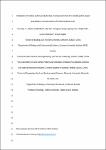Evaluating the Relative Pollen Productivity Estimates using the REVEALS model: a case study from the cultural landscape in Shandong, China
| dc.contributor.author | Li, F | |
| dc.contributor.author | Gaillard, M-J | |
| dc.contributor.author | Xie, S | |
| dc.contributor.author | Cui, Q | |
| dc.contributor.author | Fyfe, R | |
| dc.contributor.author | Marquer, L | |
| dc.contributor.author | Sugita, S | |
| dc.date.accessioned | 2023-11-07T10:44:07Z | |
| dc.date.available | 2023-11-07T10:44:07Z | |
| dc.date.issued | 2023-11-07 | |
| dc.identifier.issn | 1664-462X | |
| dc.identifier.issn | 1664-462X | |
| dc.identifier.other | ARTN 1240485 | |
| dc.identifier.uri | https://pearl.plymouth.ac.uk/handle/10026.1/21596 | |
| dc.description.abstract |
The Landscape Reconstruction Algorithm (LRA) is regarded as the soundest approach for quantifying taxon-specific plant cover from pollen data. The reliability of relative pollen productivity (RPP) estimates is fundamental in the accuracy of quantitative vegetation reconstruction using the LRA approach. Inconsistent RPP estimates produced by different studies can cast doubt on the reliability and applicability of quantitative vegetation reconstruction. Therefore, it is crucial that the RPP estimates are evaluated before being applied for quantitative vegetation reconstruction. We have tested two alternative approaches, namely, a leave-one-out cross-validation (LOO) method and a splitting-by-subregion strategy, using surface pollen assemblages and the REVEALS model—the first step in the LRA—to evaluate the reliability of RPPs estimates of 10 target taxa obtained in the cultural landscape of Shandong. We compared the REVEALS estimates (RVs) with observations of regional vegetation abundance (OBVs) and pollen proportions (PPs). The RVs of all taxa are generally closer to OBVs than PPs, and the degree of similarity depends strongly on the abundance of individual taxa in plant and pollen; taxa dominant in the region show the highest similarity between RVs and OBVs, such as Artemisia, Poaceae, and Humulus. The RVs of all herb taxa except Humulus and Asteraceae SF Cichorioideae are slightly overrepresented, and the RVs of all tree taxa are underrepresented except for Castanea. The comparison of RVs with OBVs collected from different spatial extents shows that the RVs of all herb taxa are more similar to OBVs collected from shorter distances (100 km and 75 km for the entire region and the subregion, respectively), whereas the RVs of all tree taxa are more similar to OBVs collected from longer distances (150 km and 100 km for the entire region and the subregion, respectively). Furthermore, our findings highlight the importance to test different sizes of area for vegetation surveys for evaluation of the RVs given that the appropriate size of vegetation survey may vary between low pollen producers (mainly herbs) and high pollen producers (mainly trees). We consider that the LOO strategy is the best approach in this case study for evaluating the RPP estimates from surface moss polsters. The evaluation confirms the reliability of the obtained RPP estimates for their potential application in quantitative reconstruction of vegetation abundance in temperate China. | |
| dc.format.extent | 1240485- | |
| dc.format.medium | Electronic-eCollection | |
| dc.language | eng | |
| dc.publisher | Frontiers Media | |
| dc.subject | China | |
| dc.subject | relative pollen productivity | |
| dc.subject | evaluation | |
| dc.subject | observation of regional vegetation | |
| dc.subject | REVEALS model | |
| dc.title | Evaluating the Relative Pollen Productivity Estimates using the REVEALS model: a case study from the cultural landscape in Shandong, China | |
| dc.type | journal-article | |
| dc.type | Article | |
| plymouth.author-url | https://www.ncbi.nlm.nih.gov/pubmed/38023872 | |
| plymouth.volume | 14 | |
| plymouth.publication-status | Published online | |
| plymouth.journal | Frontiers in Plant Science | |
| dc.identifier.doi | 10.3389/fpls.2023.1240485 | |
| plymouth.organisational-group | |Plymouth | |
| plymouth.organisational-group | |Plymouth|Research Groups | |
| plymouth.organisational-group | |Plymouth|Faculty of Science and Engineering | |
| plymouth.organisational-group | |Plymouth|Faculty of Science and Engineering|School of Geography, Earth and Environmental Sciences | |
| plymouth.organisational-group | |Plymouth|Research Groups|Marine Institute | |
| plymouth.organisational-group | |Plymouth|REF 2021 Researchers by UoA | |
| plymouth.organisational-group | |Plymouth|Users by role | |
| plymouth.organisational-group | |Plymouth|Users by role|Academics | |
| plymouth.organisational-group | |Plymouth|REF 2021 Researchers by UoA|UoA14 Geography and Environmental Studies | |
| plymouth.organisational-group | |Plymouth|Admin Group - REF | |
| plymouth.organisational-group | |Plymouth|Admin Group - REF|REF Admin Group - FoSE | |
| dc.publisher.place | Switzerland | |
| dcterms.dateAccepted | 2023-10-05 | |
| dc.date.updated | 2023-11-07T10:44:01Z | |
| dc.rights.embargodate | 2023-11-8 | |
| dc.identifier.eissn | 1664-462X | |
| rioxxterms.versionofrecord | 10.3389/fpls.2023.1240485 |


